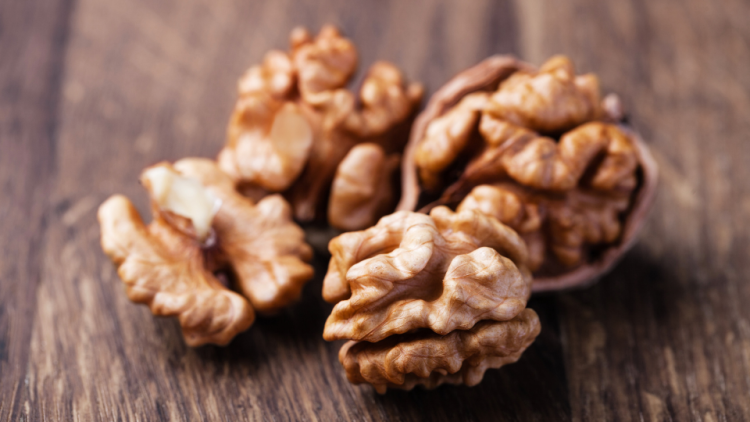Some nuts are safe for most dogs if given in small quantities, whereas others, like macadamia nuts, can be extremely toxic. So what about this variety?
Unfortunately, walnuts can be contaminated with fungi that make them toxic to dogs. If your pet consumes moldy walnuts, they might experience vomiting, liver damage, and even seizures due to toxic poisoning.
In this post, we’ll take a look at whether small amounts of walnuts are good for your pet, as well as how moldy walnuts can harm them.
Table of Contents:
- Can dogs eat walnuts?
- Walnut poisoning in dogs
- Are shelled walnuts safer for dogs?
- What about washed walnuts?
- Can dogs eat cooked walnuts?
- Are other nuts safe for dogs?
- Key Takeaways
Pro Tip: Being natural scavengers, dogs can sniff out moldy walnuts and end up with mycotoxin poisoning. Some pet insurance policies cover toxicity through ingestion, so make sure to enroll your pet on time and give yourself peace of mind.
Can dogs eat walnuts?
As you might already know, walnuts are** **rich in fatty acids, as well as a number of vitamins, minerals, and antioxidants. However, the dangers of eating walnuts outweigh any health benefits walnuts might have for dogs.
Walnuts are high in fats that can upset your dog’s stomach and cause diarrhea or vomiting. In more serious cases, consuming walnuts can lead to the development of more serious conditions like gastroenteritis or pancreatitis. Not to mention, walnuts present a potential choking hazard and might cause intestinal blockage.
Finally, the mold that grows on walnuts can be highly toxic to dogs. Moldy walnuts can contain fungi that produce tremorgenic mycotoxins. If your pet is exposed to them, he or she can have seizures and other neurological complications.
For these reasons, it’s better to stay on the safe side and not offer walnuts to your canine companion. If you still insist on feeding these nuts to your pet, be sure to consult your vet first.

Walnut poisoning in dogs
Apart from the risk of stomach upset and intestinal obstruction, walnuts can be toxic to dogs. The high moisture content of walnuts makes them quite susceptible to developing mold and fungi. Some fungi that grow on walnuts produce toxins called mycotoxins, which can be carcinogenic or cause tremors and seizures.
Dogs might show the following symptoms after ingesting walnuts:
- Panting
- Vomiting
- Restlessness
- Elevated body temperature (hyperthermia)
- Weakness
- Excess salivation
- Increased heart rates
- Dehydration
- Loss of appetite
- Muscle tremors
- Incoordination
- Seizures
- Liver damage
- Death
You should also still monitor for signs that your dog is developing an allergic reaction, which can include facial swelling, hives, trouble breathing and vomiting. If your dog has eaten a food that contains walnuts as an ingredient, the risk may be lower compared to eating a whole walnut.
In general, you should always check with your vet whether a certain food you want to introduce to your pup’s diet is safe.
Diagnosis and treatment of walnut poisoning in dogs
If you’ve seen your dog eat walnuts and they are showing the symptoms listed above, make sure to call your veterinarian. The vet will be able to confirm the diagnosis based on the symptoms and plant identification. If your pup is vomiting, the vet might also analyze the vomitus in order to reach a final diagnosis. A urinalysis and bloodwork might indicate if the kidneys or liver have been affected.
If mycotoxin poisoning is confirmed, your dog will need to be hospitalized. Depending on how long it has been since ingestion and how severe clinical signs are, your veterinarian may elect to induce vomiting to remove any remaining nuts and give activated charcoal to help absorb the toxins in their digestive system.
If your pet has severe neurologic changes, these procedures may not be safe, so it is always best to consult a veterinarian. Do not try to induce vomiting or treat your pet at home. In cases of large ingestions, gastric lavage may be performed to empty the stomach.
IV fluids are administered to flush the toxin from the system, help protect the liver and kidneys, maintain hydration in vomiting patients, and help cool the body.. The vet may use additional medications to help control vomiting, tremors, seizures, and other clinical signs. In severe cases, some pets need to be sedated or fully anesthetized to control clinical signs.
Pro Tip: Walnut poisoning is one of the most common claims for toxic ingestion. The average cost to treat walnut poisoning is $420. Compare pet insurance plans to make sure you can always afford to give your dog the best treatment for poisoning, along with many other medical conditions.
Recovery of walnut poisoning in dogs
It usually takes two to five days for dogs to recover from walnut poisoning after treatment, and once home, they will require additional care. The poisoning might leave your pet depressed and fatigued, so make sure they get enough rest.
In addition, watch for any returning symptoms, and be sure to get in touch with your vet if you notice anything unusual or if you’re concerned about your dog’s recovery rate. A follow-up appointment will be needed so that the vet can assess your pet’s health and organ function.

Are shelled walnuts safe for dogs?
No, walnuts can become infected with toxic fungi even in the shell. In fact, shelled walnuts are at a higher risk of fungal contamination, because they have zero protection.
The only reason why shelled walnuts are sometimes considered safer for dogs is that the choking hazard is reduced. Walnut shells can get stuck in the pet’s intestines and cause a blockage, especially in small breed dogs.
If your canine companion eats walnut shells, be sure to call your vet immediately.
What about washed walnuts?
Washing the walnuts might remove some of the fungal growth. One option is to wash them with vinegar. You could also use boiling water and then let the walnuts dry. However, none of these methods has proven to be 100% effective.
Although you may be able to remove most of the visible mold, fungi can still grow below the surface and the mycotoxins they create are not visible to the naked eye.
Can dogs eat cooked walnuts?
When foods are contaminated with bacteria, cooking usually kills the bacteria and makes the food safe to consume. However, cooking won’t kill mycotoxins, because they’re a chemical by-product, not living organisms.
Are other nuts safe for dogs?
Pet parents should be extra careful when feeding nuts to dogs. In general, the only ones that are considered to be less harmful are cashews, almonds, and peanuts. These nuts contain nutrients such as protein but still carry a risk of causing intestinal blockages or stomach upset.
Pet parents should also avoid feeding any nuts that contain salt or artificial flavorings and should stay away from macadamia nuts as they are particularly toxic for canines.
Key Takeaways
- The dangers of dogs eating walnuts far outweigh the health benefits.
- While it is true that fresh walnuts can provide pets with nutrients and beneficial fats, too many of them can cause stomach upset.
- Moldy walnuts are particularly dangerous as they can result in much more serious issues, including tremors and seizures.
- If you suspect your dog ate walnuts contaminated with mold, seek help from your veterinarian right away.
